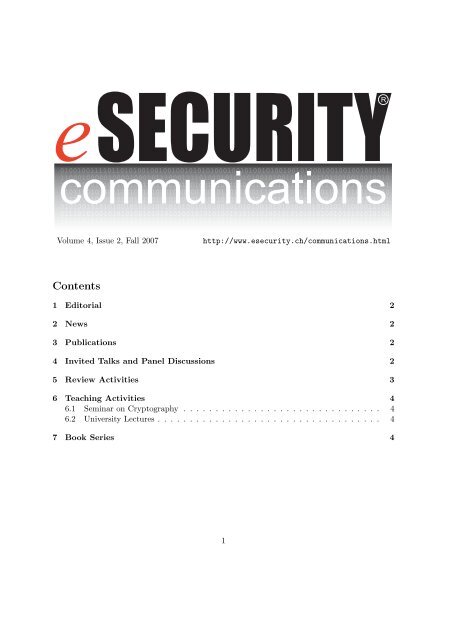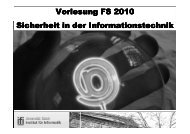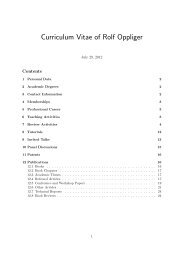communications - esecurity Technologies Rolf Oppliger
communications - esecurity Technologies Rolf Oppliger
communications - esecurity Technologies Rolf Oppliger
You also want an ePaper? Increase the reach of your titles
YUMPU automatically turns print PDFs into web optimized ePapers that Google loves.
SECURITY e01001001111011010100100100100101010100010010100101001001010001001001001001001<br />
<strong>communications</strong><br />
1100010000010000100010111000111101010101001010010100101010011010010010010010<br />
1001010011100100100110110010100100101001010101010011011101101110001110100011<br />
0101110101001100100101000100010010010110101001110010100101010101010100101010<br />
1010100101001011010100101010010101001010100101010010101010010101010010101001<br />
0101001010101001010101001010100101010010101010010101010000101010101000011101<br />
0111010100101010100101010101001010101001010101010010101010101001010101010100<br />
1010101010100101010101001010100101010010101001010100101010010101001011111101<br />
Volume 4, Issue 2, Fall 2007 http://www.<strong>esecurity</strong>.ch/<strong>communications</strong>.html<br />
Contents<br />
1 Editorial 2<br />
2 News 2<br />
3 Publications 2<br />
4 Invited Talks and Panel Discussions 2<br />
5 Review Activities 3<br />
6 Teaching Activities 4<br />
6.1 Seminar on Cryptography . . . . . . . . . . . . . . . . . . . . . . . . . . . . . . . 4<br />
6.2 University Lectures . . . . . . . . . . . . . . . . . . . . . . . . . . . . . . . . . . . 4<br />
7 Book Series 4<br />
1<br />
R
1 Editorial<br />
Welcome to the fall 2007 issue of eSECURITY <strong>communications</strong>.<br />
There is a famous anecdote about a bank robber<br />
who—being asked why he robs banks—answered with<br />
“because this is where the money is.” At first sight,<br />
this answer seems obvious and trivial (maybe too trivial<br />
to be mentioned in the first place). But at second<br />
sight, the answer is still noteworthy, mainly because it<br />
is symptomatical for all security considerations related<br />
to electronic commerce: if there is money, then there is<br />
also crime, or—alternatively speaking—crime follows<br />
money. On the defense side, this insight suggests that<br />
one must take a differentiating view when one discusses<br />
and considers the use of security measures. Such measures<br />
only make sense, if they mitigate specific risks.<br />
If there is no risk, then it is useless to spend money<br />
on security measures in the first place. This risk-based<br />
approach to information security has started to take off<br />
in the last couple of years. Today, any disquisition of<br />
security technologies, mechanisms, and services should<br />
start with a threat model (i.e., a model that elaborates<br />
on the types of attacks one wants to protect against).<br />
If crime follows money, then it is not suprising that<br />
organized crime has sights on Internet banking, and<br />
that all major banks are subject to phishing, pharming,<br />
Web spoofing, man-in-the-middle, and malware<br />
attacks. Note that these attacks do not address the<br />
server systems of the banks, but rather the client systems<br />
of their clientele. Consequently, the usefulness<br />
and effectiveness of Internet banking as a whole is<br />
up for discussion, and there are many conclusions one<br />
may draw. For example, one may question the use of<br />
commercial off-the shelf browsers (e.g., Microsoft Internet<br />
Explorer or Mozilla Firefox) for Internet banking.<br />
Maybe the use of proprietary (and more static)<br />
client software is advantageous from a security viewpoint.<br />
This argument can be discussed controversially.<br />
Taking the discussion one step further, one may even<br />
argue about the future of software-open computer systems<br />
for security-critical applications. The alternative<br />
would be software-controlled or even software-closed<br />
computer systems, such as the ones being discussed in<br />
the context of trusted computing. Such a discussion<br />
is beyond the aims and scope of eSECURITY <strong>communications</strong>,<br />
but we are still interested in knowing your<br />
thoughts. We invite you to write them down and submit<br />
them for possible publication in eSECURITY <strong>communications</strong>.<br />
We are interested in having a discussion<br />
about this important and practically influential topic.<br />
In any case, we hope that you enjoy reading this<br />
2<br />
issue of eSECURITY <strong>communications</strong>, and we are looking<br />
forward hearing from you and receiving your feedback,<br />
comments, or criticism.<br />
2 News<br />
In May 2007, <strong>Rolf</strong> <strong>Oppliger</strong> was appointed adjunct professor<br />
at the University of Zürich, Switzerland, where he<br />
will continue to lecture regularly on information technology<br />
(IT) security. The next lecture is scheduled for<br />
spring 2008 (cf. Section 6.2).<br />
3 Publications<br />
An overview article entitled “SSL/TLS Session-Aware<br />
User Authentication: A Lightweight Alternative to<br />
Client-Side Certificates” (co-authored by Ralf Hauser<br />
and David Basin) has been accepted for publication<br />
and will appear in a future issue of the IEEE Computer<br />
magazine. The article elaborates on the feasibility<br />
of man-in-the-middle (MITM) attacks in an<br />
SSL/TLS setting, surveys possible countermeasures,<br />
examines the rationale behind SSL/TLS session-aware<br />
(TLS-SA) user authentication as a lightweight alternative<br />
to client-side certificates, and overviews and discusses<br />
different possibilities for making user authentication<br />
mechanisms be SSL/TLS session-aware. Due to<br />
the large readership of the IEEE Computer magazine,<br />
we expect a serious discussion about TLS-SA taking<br />
place after the publication of the article. We will keep<br />
you informed.<br />
4 Invited Talks and Panel Discussions<br />
As a member of the technical program committee, <strong>Rolf</strong><br />
<strong>Oppliger</strong> took part in the 4th International Conference<br />
on Trust, Privacy and Security in Digital Business<br />
(TrustBus ’07 1 ) held on September 3–7, 2007, in<br />
conjunction with the renowned 18th International Conference<br />
on Database and Expert Systems Applications<br />
(DEXA 2007) in Regensburg (Germany).<br />
During the conference, <strong>Rolf</strong> <strong>Oppliger</strong> participated<br />
in a panel discussion entitled “Managing Digital<br />
Identities—Challenges and Opportunities.” Other<br />
panel particpants included (in alphabetical order):<br />
• Marco Casassa-Mont from HP Labs in Bristol<br />
(UK)<br />
1 http://www.icsd.aegean.gr/trustbus07/
• Eduardo B. Fernández from Florida Atlantic<br />
University (USA)<br />
• Socrates Katsikas from the University of Piraeus<br />
(Greece)<br />
• Alfred Kobsa from UC Irvine (USA)<br />
The panel was chaired and moderated by Günther Pernul<br />
from the University of Regensburg (Germany).<br />
Identity management is an important and very<br />
timely topic that is sometimes discussed controversially<br />
even within the information security community. The<br />
term identity management is still vaguely defined and<br />
comprises the management of entities, identities, identifiers,<br />
privileges and access rights, as well as identification<br />
cards.<br />
• According to RFC 2828, the term entity refers<br />
to “an active element of a system—e.g., an automated<br />
process, a subsystem, a person or group<br />
of persons—that incorporates a specific set of<br />
capabilities.” In a typical setting, entities represent<br />
persons or legal entities, such as companies<br />
or organizations.<br />
• There are many definitions of the term identity<br />
that can be found in the literature. The greatest<br />
common denominator of all these definitions<br />
is that an identity refers to some set of qualities<br />
(or attributes) that make an entity unique<br />
and different from other entities. Alternatively<br />
speaking, it is the individual characteristics by<br />
which an entity is recognized or known in a specific<br />
community. Consequently, an entity may<br />
have several identities—depending on the context<br />
in which it resides—and each identity can<br />
be characterized by a set of attributes.<br />
• Every identity (of an entity) may have one (or<br />
several) identifier(s) that refers (refer) to it. In<br />
the simplest case, an identifier is just a name,<br />
an employee number, a social security number,<br />
or something similar. In some situations, the<br />
identifier is unique; in other situations it is not.<br />
• Every identity (of an entity) may have a set of<br />
privileges and access rights associated with it.<br />
While the identity is the basis for authentication,<br />
privileges and access rights are the basis<br />
for authorization. In theory, authentication and<br />
authorization can be conceptually separated. In<br />
practice, however, authentication and authorization<br />
are often combined and implemented in<br />
an authentication and authorization infrastructure<br />
(AAI), a privilege management infrastructure<br />
(PMI), or an infrastructure with some other<br />
name.<br />
3<br />
When people talk about identity management, they often<br />
mix up the terms itemized above with the notion of<br />
an identification card (ID card). In the physical world,<br />
people are using and are accustomed to the use of ID<br />
cards. In essence, an ID card attests for the legitimacy<br />
of an identity (or its attributes, respectively). There<br />
are ID cards for all kinds of purposes: passports and<br />
ID cards issued by the state, employee cards issued by<br />
companies, membership and customer cards issued by<br />
all kinds of organizations and companies, student cards<br />
issued by universities, and so on. In spite of the fact<br />
that multiple-use ID cards are technically feasible, most<br />
ID cards in use today are single-use, meaning that they<br />
serve one single purpose or application. There may<br />
be many reasons for this fact—an important reason is<br />
certainly the fact that an ID card is also to serve customer<br />
relationship (so ID card-issuing organizations are<br />
reserved in sharing the cards with other organizations).<br />
The omnipresence of single-use ID cards results in wallets<br />
that are filled with all sorts of cards. We know<br />
the problem from daily life, and hence we decide on<br />
a case-to-case basis which card to employ in a given<br />
context. In the latest issue of eSECURITY <strong>communications</strong><br />
(Volume 4, Issue 1, Spring 2007), we elaborated<br />
on Microsoft’s identity metasystem and the CardSpace<br />
implementation thereof. CardSpace tries to mimic the<br />
real-world experience with multiple ID cards serving<br />
different purposes.<br />
In his panel position statement, <strong>Rolf</strong> <strong>Oppliger</strong><br />
stressed the point that it is important to specifiy what<br />
one is really referring to when one is talking about identity<br />
management. There are different viewpoints and<br />
perspectives on the topic. For example, from a technology<br />
perspective there are many authentication and<br />
authorization technologies that can be used to manage<br />
identities. Some are based on the Kerberos authentication<br />
system (one could call them 1 st generation<br />
technologies), some are based on digital certificates<br />
and public key infrastructures (one could call them 2 nd<br />
generation technologies), and some are based on Webbased<br />
single sign-on (SSO) services (one could call them<br />
3 rd generation technologies). There was in fact consensus<br />
among the panelists that there are many technologies<br />
available, but that there are also organizational,<br />
procedural, and legal issues to resolve before the technologies<br />
can be deployed on a large scale.<br />
5 Review Activities<br />
In addition to the conferences and workshops itemized<br />
in the last issue of eSECURITY <strong>communications</strong>, <strong>Rolf</strong>
<strong>Oppliger</strong> served as a member of the programm committee<br />
for the 2nd International Conference on Systems<br />
and Networks Communications (ICSNC ’07) that took<br />
place on August 25–31, 2007, in Cap Esterel (France).<br />
More recently, <strong>Rolf</strong> <strong>Oppliger</strong> was appointed Associate<br />
Editor of a new and upcoming John Wiley & Sons<br />
journal entitled Security and Communication Networks<br />
(SCN). 2 We are confident of turning the journal into<br />
recommended reading for any professional working on<br />
network security. The first issue of the journal will appear<br />
in 2008. If you are interested in writing a paper<br />
for possible publication in the SCN, then please feel<br />
free to contact <strong>Rolf</strong> <strong>Oppliger</strong> or any other member of<br />
the editiorial board.<br />
6 Teaching Activities<br />
The eSECURITY EDUCATION CENTER 3 has a<br />
break, but <strong>Rolf</strong> <strong>Oppliger</strong> still continues to teach courses<br />
and seminars and to lecture at universities.<br />
6.1 Seminar on Cryptography<br />
On behalf of InfoGuard AG 4 and Crypto AG 5 , <strong>Rolf</strong><br />
<strong>Oppliger</strong> taught an international seminar on Contemporary<br />
Cryptography on June 25–29, 2007. The seminar<br />
is based on <strong>Rolf</strong> <strong>Oppliger</strong>’s book with the same title.<br />
It provides an overview and introduction to the current<br />
state-of-the-art in cryptography. The seminar is held in<br />
English and usually takes place in Zug. The next seminar<br />
is scheduled for November 26–30, 2007. If you are<br />
interested to participate, then you may register or request<br />
a flyer from InfoGuard, Crypto, or eSECURITY<br />
<strong>Technologies</strong> <strong>Rolf</strong> <strong>Oppliger</strong>.<br />
In 2008, the seminar on Contemporary Cryptography<br />
is provisorily scheduled for April 21–25, June 23–27,<br />
and November 24–28. It would give us great pleasure<br />
to meet you there.<br />
6.2 University Lectures<br />
In spring 2008 (starting on February 18, 2008), <strong>Rolf</strong><br />
<strong>Oppliger</strong> will lecture at the University of Zürich on<br />
information technology security (the original title of<br />
the lecture is “Sicherheit in der Informationstechnik”).<br />
Note that the lecture will henceforth take place in the<br />
2 http://www.interscience.wiley.com/journal/<br />
security<br />
3 http://www.<strong>esecurity</strong>.ch/education.html<br />
4 http://www.infoguard.ch<br />
5 http://www.crypto.ch<br />
4<br />
spring semester (instead of the summer semester). The<br />
slides are being revised and will be made electronically<br />
available on the lecture’s home page 6 soon. The final<br />
examn of the lecture will take place on May 26, 2008.<br />
7 Book Series<br />
Since the publication of the last issue of eSECURITY<br />
<strong>communications</strong>, the following book was published in<br />
the information security and privacy book series of<br />
Artech House:<br />
• Edward Humphreys, Implementing the ISO/IEC<br />
27000 Information Security Management System<br />
Standard, ISBN-10 1596931728, ISBN-13<br />
978-1596931725, 2007.<br />
With the increasing importance of ISO 27000compliant<br />
information security management systems<br />
(ISMS), we think that this book hits the market in the<br />
right time. Also, Ted is one of the leading persons in<br />
the ISO 27000 community, so it is partiucularly interesting<br />
and stimulating to hear (or rather read) what he<br />
has to say about the topic.<br />
The process of contracting new authors is going on.<br />
If you are interested in writing and publishing a book in<br />
the series, then you may contact either the Series Editor<br />
(<strong>Rolf</strong> <strong>Oppliger</strong>) or a Commissioning Editors (refer to<br />
the book series’ home page 7 for the coordinates of the<br />
Commissioning Editors).<br />
About the Company<br />
eSECURITY <strong>Technologies</strong> <strong>Rolf</strong> <strong>Oppliger</strong> 8 is an independent<br />
and privately owned company founded in October<br />
1999 to provide scientific and state-of-the-art consulting,<br />
education, and engineering services related to<br />
information technology (IT) security. The company is<br />
registered in the commercial register of Bern-Mittelland<br />
(CH-035.1.023.622-7) and is located in Gümligen near<br />
Berne (Switzerland).<br />
c○ 2007 eSECURITY <strong>Technologies</strong> <strong>Rolf</strong> <strong>Oppliger</strong><br />
6 www.<strong>esecurity</strong>.ch/Teaching/uni-zh-2008.shtml<br />
7 www.<strong>esecurity</strong>.ch/serieseditor.html<br />
8 www.<strong>esecurity</strong>.ch





